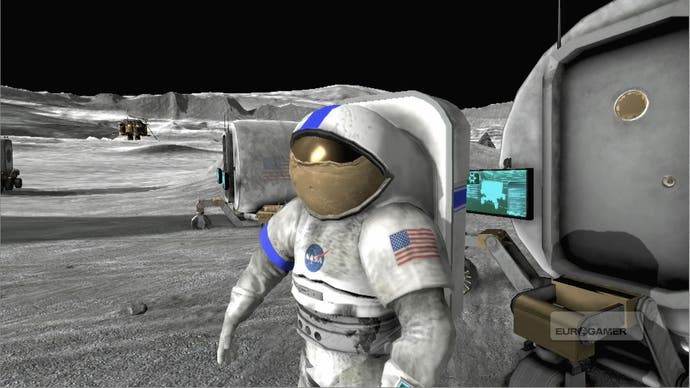Moonbase Alpha
Science fare.
It's a sad fact that, despite the daydreams of millions of children worldwide, the jobs which we want to do when we're young actually turn out to be pretty tedious.
Take train driving, for example - that's pretty boring. Like normal driving, but without the steering, roundabouts or the drive-through McDonald's. Firefighting's another, with every dramatic rescue of a beautiful woman from a burning orphanage bracketed by a million and one calls to get a fat child's head extracted from the school railings.
With Moonbase Alpha another childhood illusion is shattered - the life of an astronaut appears to be largely slow, dull and pretty repetitive.
That's not to say that there aren't any exciting bits. Boosting out of the atmosphere at 26,000 mph is probably quite exhilarating, as is popping out of the shuttle for a bit of EVA and snap-taking for the folks back home. But Moonbase Alpha isn't about any of those things.
Because Moonbase Alpha is basically a NASA recruitment tool - developed in partnership with the people who created US Army propaganda game America's Army - fantasy and drama largely tip their moon-hats to the prosaic and mundane, at least in deed, if not in concept.

This free game is designed around online collaboration, with small-scale instances available in three different sizes depending on how many players you can gather. Unsurprisingly, the servers are about as sparsely populated as the moon itself at the moment, so collaborative play was out during our play-test. Instead, I tackled the smallest map, recommended for one or two space-faring hopefuls, bravely stepping out solo onto the unforgiving lunar regolith.
It all begins with a glowing, neon back-story, presented in a textual, seventies vision of the future. NASA has established a moonbase, it explains. Everything is hunky-dory, despite the Agency deciding to name it after a fictional settlement from a Gerry Anderson sci-fi show. My nameless, faceless astronaut is on his way back from a little jaunt around the satellite when disaster occurs - the life support systems for the moonbase are struck by a meteorite, causing massive damage to solar panels, power couplings and oxygen generators - leaving a matter of minutes in which to fix them before the researchers inside asphiate.
As it turns out, either everyone at NASA is on enough diazepam to keep both Keith Richards and Shaun Ryder doing jigsaw puzzles all day, or they've actually been conditioned so brilliantly that their response to a massive, life-threatening crisis is to request your help in an impossibly calm, flat, even monotone. That, or they really couldn't find any decent voice actors.
Either way, it's down to you, or you and a few others if you find a populated instance running, to get out there and perform those menial repairs before total system failure destroys the cream of the Western scientific community.

Let the excitement commence!
It's not a massively visually arresting experience. Depicted in the ubiquitous Unreal Engine 3, the moon is grey, dusty and pitted with craters, which seems reasonable enough, although it seems unlikely that the lunar surface is quite as jaggy. A star field (fictional) is an optional extra, and the Earth sparkles wistfully above the horizon. To be fair to Moonbase Alpha, looking good is rarely a point of pride for educational software, but my hopes of total lunar immersion are quickly dashed, despite the constant Darth Vader noises I'm making at my desk.
My heavily-suited avatar bounces across the dusty plain with what I can only assume is realistic joie-de-vivre, en route to the beleaguered processing plants, off in the distance. Once at the "tool shed", the action begins in earnest - it's time to start making choices.
At one end of the wrecked equipment chain are the solar panels, with a line of power cables joining them to the gas-producing modules. The cables and the panels can be fixed by hand, or at least by welding torch, but the coolant spewing from the oxygen plants is far too dangerous to approach in person - necessitating the use of a remotely controlled robot.

